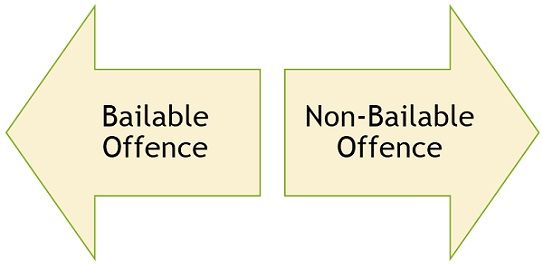

Under the Code of Criminal Procedure (CrPC), based on bail, offences can be classified as – bailable offences and non-bailable offences, wherein the former implies those offences in which bail can be granted to the accused. On the other hand, the latter signifies those offences in which bail cannot be granted in general circumstances.
Bail is when the accused is freed from the custody of police officers and entrusting him to the sureties, provided the accused to be produced to answer the alleged charge at the stipulated date and time. So, bail is nothing but the freedom granted to the accused.
Offence can be described as any act or omission which is punishable under any law, which is in force from time to time. Also, it covers any act, in relation to which any complaint has been lodged u/s 20 of Cattle Trespass Act, 1871.
| Basis for Comparison | Bailable Offence | Non-Bailable Offence |
|---|---|---|
| Meaning | A bailable Offence is one that is less serious in nature. It implies an offence in relation to which bail is available to the accused. | A non-bailable offence is an offence that is serious in nature and in relation to which bail is not available to the accused in general. |
| Quantum of Punishment | Punishment is for less than 3 years. | Punishment is for more than 3 years. |
| Grant of Bail | Matter of Right | Discretion of Court |
| Bail Granting authority | Investigating officer or officer in charge of the police station. | Judicial Magistrate or Judge |
| Bail Procedure | When the accused brings proper surety after his/her arrest, the investigating officer is bound to release the accused. | Investigating officer is required to present the accused before the magistrate within 24 hours of his/her arrest. At that time, he/she can make an application of bail to the magistrate either by himself or through a lawyer. |
| Bail bond | To be executed with or without producing surety. | To be executed with stringent conditions. |
As per law any offence indicated in the First Schedule as bailable, or the one made bailable by any other law which is in force from time to time, is called a bailable offence.
There are two parts of the First Schedule of CrPC, in which part I concerns itself with offences given under the Indian Penal Code, whereas part II is related to offences under other laws. Further, the last item of the First Schedule states that an offence can be called bailable, when it is punishable with imprisonment for less than 3 years or fine only.
Under section 436 of the Criminal Procedure Code, provisions relating to bail in the case of bailable offence has been discussed. As per this section, when the person is charged with the commission of an offence that is bailable in nature, bail is the right of the accused because it casts a binding duty on the police officer in charge of the police station and the court as well to release the accused, when the offence is bailable.
Non-bailable Offence refers to any offence which is not a bailable offence. As per law, it includes all such offences that are not included in the First Schedule of CrPC, as a bailable offence.
Moreover, the end of the second part of the First Schedule defines non-bailable offences like the ones which are punishable with death, life imprisonment or imprisonment for 7 years or more.
After developing a thorough understanding of these two, let’s move further to discuss the difference between bailable offence and non-bailable offence:
Bail refers to the process of obtaining the temporary release of an accused who is charged with a crime, by making certain his attendance in the court in future for trial and compelling the accused to stay in the court’s jurisdiction, until he is found, innocent by the court.
Criminal proceedings rely on the prima facie (i.e. at first instance) assumption of guilt. As well as there is a presumption of innocence in support of the accused. While bail acts as the presumption of innocence, the conditions of bail such as presentation in the court on the stipulated date and time act as the prima facie assumption of guilt.
The purposes of granting bail are:
| Bailable Offence | The accused needs to fill a form, specified in the first schedule of CrPC, and submit the same with the stipulated authority, then the Court will have to grant bail. |
| Non-Bailable Offence | The accused is required to fill the certain form, specified in the First Schedule of CrPC and submit the same, to apply for bail. Thereafter, it is the Court that decides to grant bail to the accused or reject the application. |
The Criminal Procedure Code (CrPC) has not given any reason regarding the basis on which classification between bailable and non-bailable offence has been made. So, there is a simple arbitrary classification of the offences covered under the two categories. Hence, one can rationally infer that all heinous crimes fall under the category of non-bailable offence, whereas those less serious ones are covered under bailable offence.